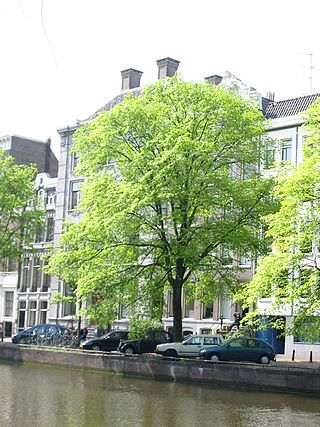
The hybrid elm cultivar Ulmus × hollandica 'Belgica', one of a number of hybrids arising from the crossing of Wych Elm with a variety of Field Elm, was reputedly raised in the nurseries of the Abbey of the Dunes, Veurne, in 1694. Popular throughout Belgium and the Netherlands in the 19th century both as an ornamental and as a shelter-belt tree, it was the 'Hollandse iep' in these countries, as distinct from the tree known as 'Dutch Elm' in Great Britain and Ireland since the 17th century: Ulmus × hollandica 'Major'. In Francophone Belgium it was known as orme gras de Malines.
The hybrid elm cultivar Ulmus × hollandica 'Dauvessei', one of a number of cultivars arising from the crossing of the Wych Elm U. glabra with a variety of Field Elm U. minor, is a very rare cultivar said to have originated at the D. Dauvesse nursery in Orléans, France before 1877.
The elm cultivar Ulmus 'Atropurpurea' [:dark purple] was raised from seed at the Späth nursery in Berlin, Germany, circa 1881, as Ulmus montana atropurpurea, and was marketed there till the 1930s, being later classed as a cultivar by Boom. Henry (1913) included it under Ulmus montana cultivars but noted that it was "very similar to and perhaps identical with" Ulmus purpureaHort. At Kew it was renamed U. glabraHuds. 'Atropurpurea', but Späth used U. montana both for wych elm and for some U. × hollandica hybrids, so his name does not necessarily imply a wych elm cultivar. The Hesse Nursery of Weener, Germany, however, which marketed 'Atropurpurea' in the 1950s, listed it in later years as a form of U. glabraHuds..

The elm cultivar Ulmus 'Purpurea', the purple-leaved elm, was listed and described as Ulmus Stricta Purpurea, the 'Upright Purpled-leaved Elm', by John Frederick Wood, F.H.S., in The Midland Florist and Suburban Horticulturist (1851), as Ulmus purpureaHort. by Wesmael (1863), and as Ulmus campestris var. purpurea, syn. Ulmus purpureaHort. by Petzold and Kirchner in Arboretum Muscaviense (1864). Koch's description followed (1872), the various descriptions appearing to tally. Henry (1913) noted that the Ulmus campestris var. purpureaPetz. & Kirchn. grown at Kew as U. montana var. purpurea was "probably of hybrid origin", Ulmus montana being used at the time both for wych elm cultivars and for some of the U. × hollandica group. His description of Kew's U. montana var. purpurea matches that of the commonly-planted 'Purpurea' of the 20th century. His discussion of it (1913) under U. campestris, however, his name for English Elm, may be the reason why 'Purpurea' is sometimes erroneously called U. procera 'Purpurea' (as in USA and Sweden.

The elm cultivar Ulmus 'Crispa' [:'curled', the leaf margin], sometimes known as the Fernleaf Elm, arose before 1800 and was first listed by Willdenow as U. crispa (1809). Audibert listed an U. campestrisLinn. 'Crispa', orme à feuilles crépues [:'frizzy-leaved elm'], in 1817, and an Ulmus urticaefolia [:'nettle-leaved elm'] in 1832; the latter is usually taken to be a synonym. Loudon considered the tree a variety of U. montana (1838). In the 19th century, Ulmus × hollandica cultivars, as well as those of Wych Elm, were often grouped under Ulmus montana. Elwes and Henry (1913) listed 'Crispa' as a form of wych elm, but made no mention of the non-wych samara.
The elm cultivar Ulmus 'Monstrosa' [: "monstrous", "strange"], a shrub-elm with fasciated branching, is believed to have originated in France, where it was first listed by Lavallée in Arboretum Segrezianum (1877) as a form of Field Elm, Ulmus campestris var. monstrosa, but without description. Though its long slender 2 cm petiole is not a feature of wych elm U. glabraHuds., and is even less likely in a shrub form of this species, the wych-cultivar error arose early, perhaps because the Späth nursery of Berlin, using Ulmus montana both for some Ulmus × hollandica cultivars and for wych varieties, listed it c.1890 as Ulmus montana monstrosa. Hartwig in Illustrirtes Gehölzbuch (1892) followed with Ulmus scabra monstrosa, an error repeated by Krüssman (1962) and by Green (1964), with their U. glabraHuds. 'Monstrosa'.
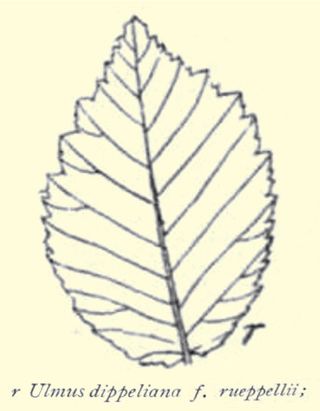
Ulmus minor 'Rueppellii' is a Field Elm cultivar said to have been introduced to Europe from Tashkent by the Späth nursery, Berlin. Noted in 1881 as a 'new elm', it was listed in Späth Catalogue 73, p. 124, 1888–89, and in subsequent catalogues, as Ulmus campestris Rueppelli, and later by Krüssmann as a cultivar.
The putative Wych Elm cultivar Ulmus glabra 'Dovaei', or Doué elm, was raised by the André Leroy nursery at Angers, France, as Ulmus dovaei, before 1868. The Baudriller nursery of Angers marketed it as Ulmus Dowei, "orme de Doué", suggesting a link with the royal nurseries at nearby Doué-la-Fontaine, which stocked elm. Green considered it a form of wych.
The putative Wych Elm cultivar Ulmus glabra 'Holgeri' originated in Sweden, where it was described by Holger Jensen of Ramlösa Plantskola, Helsingborg, in 1921. It was distributed by the Späth nursery of Berlin in the 1920s and '30s as Ulmus montana Holgeri. Späth used U. montana both for wych and for U. × hollandica hybrids like 'Dampieri', so the name does not necessarily imply a wych cultivar. In The Netherlands the tree was classified as an Ulmus × hollandica hybrid, a 1932 herbarium specimen from a tree in The Hague supplied by Späth being labelled Ulmus hollandica var. holgeri (Jensen).
The putative Wych Elm cultivar Ulmus glabra 'Latifolia Nigricans' was first described, as Ulmus campestris latifolia nigricans, by Pynaert in 1879. Pynaert, however, did not specify what species he meant by U. campestris. The tree was supplied by the Späth nursery of Berlin in the late 19th century and early 20th as Ulmus montana latifolia nigricans. Späth, like many of his contemporaries, used U. montana both for Wych Elm cultivars and for those of the U. × hollandica group.
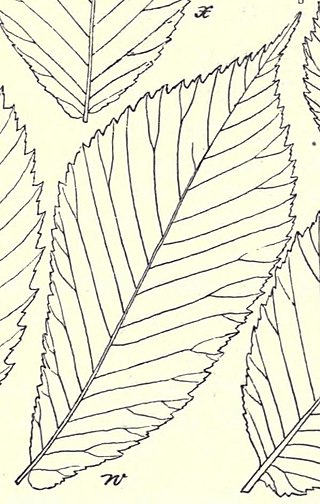
The putative Wych Elm cultivar Ulmus glabra 'Macrophylla' [literally 'long-leaved', though also 'large-leaved'] was first mentioned by Lavallée in 1877 as U. montana var. macrophylla (fastigiata). The Späth nursery of Berlin marketed an U. montana macrophylla in the late 19th and early 20th century; both Späth and the Hesse Nursery of Weener, Germany, supplied it in the 1930s. At that time, Ulmus montana was used both for wych elm cultivars and for hybrid cultivars of the Ulmus × hollandica group.
The elm cultivar Ulmus 'Rugosa' [:'wrinkled', the leaves], was first listed in Audibert's Tonelle (1817), as "U. campestris Linn. 'Rugosa' = orme d'Avignon [Avignon elm] ", but without description. A description followed in the Revue horticole, 1829. Green (1964) identified this cultivar with one listed by Hartwig and Rümpler in Illustrirtes Gehölzbuch (1875) as Ulmus montana var. rugosaHort.. A cultivar of the same name appeared in Loddiges' catalogue of 1836 and was identified by Loudon in Arboretum et Fruticetum Britannicum (1838) as Ulmus montana var. rugosaMasters, Masters naming the tree maple-bark elm. Ulmus montana was used at the time both for wych cultivars and for some cultivars of the Ulmus × hollandica group.
Ulmus × hollandica 'Pitteurs' or 'Pitteursii', one of a number of hybrid cultivars arising from the crossing of the Wych Elm Ulmus glabra with a variety of Field Elm Ulmus minor, was first identified by Morren as l'orme Pitteurs (1848). Elwes and Henry (1913) and Krüssmann (1976) listed it as an Ulmus × hollandica cultivar. It was named after the landowner Henri Bonaventure Trudon de Pitteurs of Saint-Trond, near Liège, Belgium, who discovered and first propagated the tree on his estate.

The hybrid elm cultivar Ulmus × hollandica 'Superba' is one of a number of intermediate forms arising from the crossing of the Wych Elm U. glabra with a variety of Field Elm U. minor. Boulger tentatively (1881) and Green more confidently (1964) equated it with a hybrid elm cultivated in the UK by Masters at Canterbury in the early 19th century, known as "Masters' Canterbury Seedling" or simply the Canterbury Elm. Loudon examined a specimen sent by Masters and considered it a hybrid, calling it U. montana glabra major.

The hybrid elm cultivar Ulmus × hollandica 'Gaujardii', one of a number of cultivars arising from the crossing of Wych Elm U. glabra with Field Elm U. minor, was raised by the Gaujard-Rome nursery of Châteauroux, France, in the 1890s as Ulmus Gaujardii and was described in the 1898 Kew Bulletin and Wiener illustrirte Garten-Zeitung. It won first prize in the International Horticultural Exhibition in Saint Petersburg, Russia, in 1899 and a silver medal in the Heemstede Exhibition, The Netherlands, in 1925. From the early 20th century it was distributed by the Späth nursery of Berlin as Ulmus montana Gaujardi, and in the interwar years by the Boccard nursery of Geneva as Ulmus campestris Gaujardi. It appeared in Unsere Freiland-Laubgehölze in 1913, but without description.
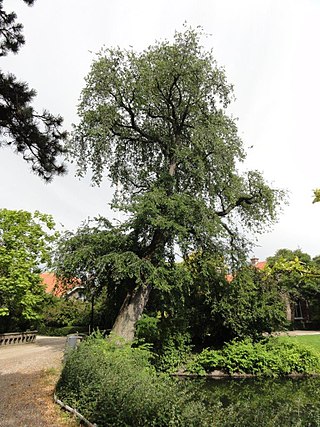
The Field Elm cultivar Ulmus minor 'Pendula' was said to have been raised in Belgium in 1863. It was listed as Ulmus sativa pendula by C. de Vos in 1887, and by Boom in 1959 as a cultivar.

The elm cultivar Ulmus 'Scampstoniensis', the Scampston Elm or Scampston Weeping Elm, is said to have come from Scampston Hall, Yorkshire, England, before 1810. Loudon opined that a tree of the same name at the Royal Horticultural Society's Garden in 1834, 18 feet (5.5 m) high at 8 years old "differed little from the species". Henry described the tree, from a specimen growing in Victoria Park, Bath, as "a weeping form of U. nitens" [:Ulmus minor ]; however Green considered it "probably a form of Ulmus × hollandica". Writing in 1831, Loudon said that the tree was supposed to have originated in America. U. minor is not, however, an American species, so if the tree was brought from America, it must originally have been taken there from Europe. There was an 'American Plantation' at Scampston, which may be related to this supposition. A number of old specimens of 'Scampstoniensis' in this plantation were blown down in a great gale of October 1881; younger specimens were still present at Scampston in 1911.
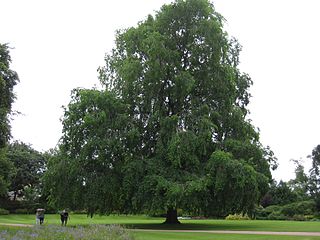
Ulmus × hollandica 'Wentworthii Pendula', commonly known as the Wentworth Elm or Wentworth Weeping Elm, is a cultivar with a distinctive weeping habit that appears to have been introduced to cultivation towards the end of the 19th century. The tree is not mentioned in either Elwes and Henry's or Bean's classic works on British trees. The earliest known references are Dutch and German, the first by de Vos in Handboek tot de praktische kennis der voornaamste boomen (1890). At about the same time, the tree was offered for sale by the Späth nursery of Berlin as Ulmus Wentworthi pendulaHort.. The 'Hort.' in Späth's 1890 catalogue, without his customary label "new", confirms that the tree was by then in nurseries as a horticultural elm. De Vos, writing in 1889, states that the Supplement to Volume 1 includes entries announced since the main volume in 1887, putting the date of introduction between 1887 and 1889.

The elm cultivar Ulmus 'Fastigiata Glabra' was distributed by the Späth nursery, Berlin, in the 1890s and early 1900s as U. montana fastigiata glabra. Späth used U. montana both for cultivars of wych elm and for those of some U. × hollandica hybrids like 'Dampieri'. A specimen of U. montana fastigiata glabra in the Royal Botanic Garden Edinburgh was determined by Melville in 1958 as a hybrid of the U. × hollandica group.

The wych elm cultivar Ulmus glabraHuds. 'Superba', Blandford Elm, with unusually large leaves, was raised by Gill's of Blandford Forum, Dorset, in the early 1840s as Ulmus montana superba and was quickly distributed to other UK nurseries. It was confirmed as a form of wych, and first described by Lindley in The Gardeners' Chronicle, 1845, later descriptions being added by Gill (1845) and Morren (1848), who called it U. montana var. superba. Morren had adopted the name 'Superba' from the Fulham nurseryman Osborne in 1844, who supplied him with the tree – presumably one of the nurseries supplied by Gill. Morren states that 'Superba', already in cultivation in England, was introduced to Belgium by Denis Henrard of Saint Walburge, Liège, that in 1848 it had been present in Belgium for only three years, and that this variety was the one described as 'Superba' by Osborne, whom Henrard had visited at his nursery in Fulham in September 1844. 'Blandford Elm', with leaves of the same dimensions, was soon for sale in the USA.




















